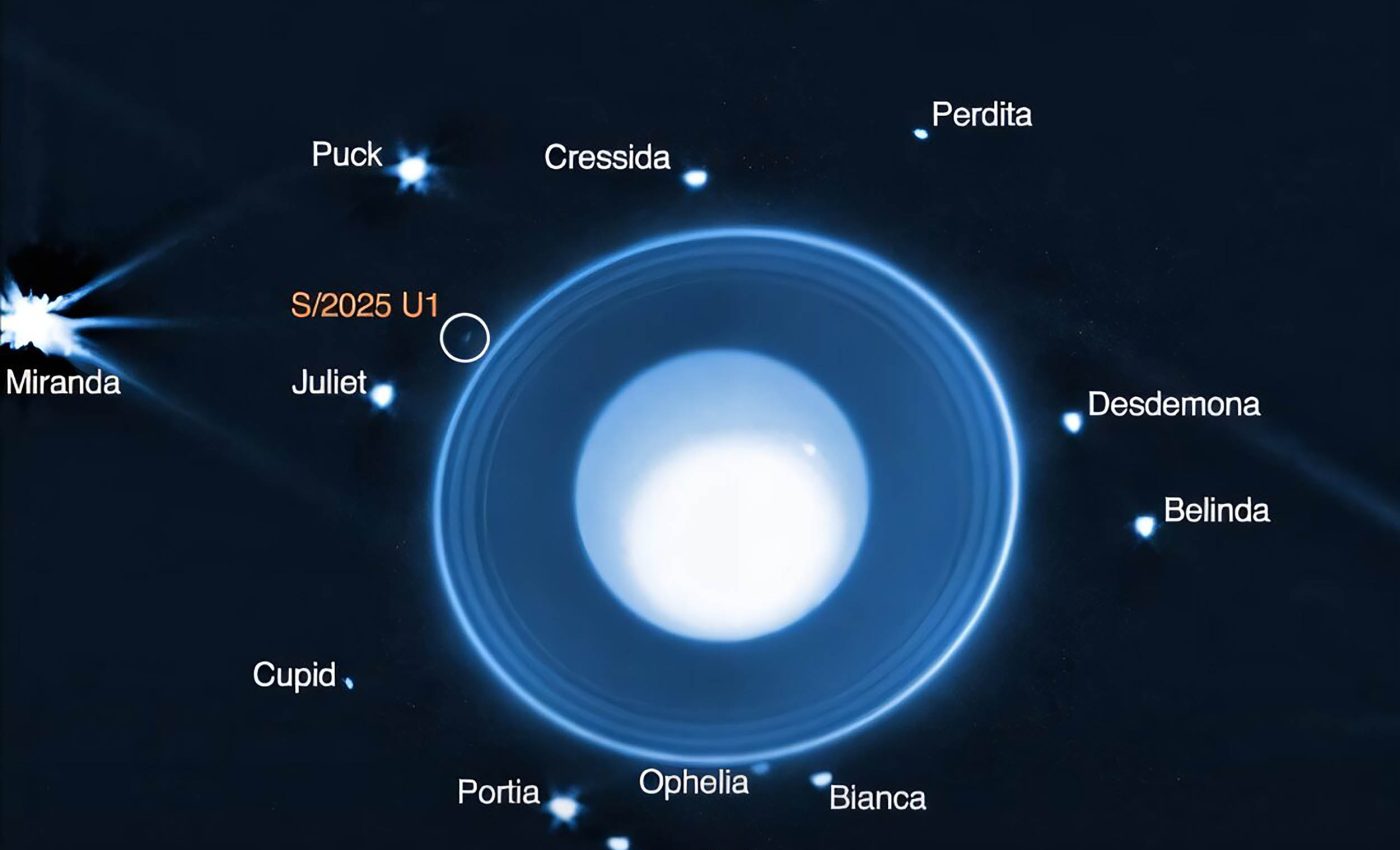
Webb telescope strikes again finding a new moon orbiting Uranus
Astronomers have spotted a tiny, previously unknown moon circling Uranus. The discovery raises the planet’s moon tally to 29. The satellite is only about six miles across and orbits the planet’s inner system. Its faint glow explains why it escaped earlier searches.
A team led by the Southwest Research Institute (SwRI) identified the body in James Webb Space Telescope (JWST) images taken back on February 2, 2025.
The detection came from a set of very long exposures designed to probe the dim environment near Uranus.
“This object was spotted in a series of ten 40-minute long-exposure images captured by the Near-Infrared Camera (NIRCam),” said Maryame El Moutamid, a lead scientist in SwRI’s Solar System Science and Exploration Division, based in Boulder, Colorado.
“It’s a small moon but a significant discovery, which is something that even NASA’s Voyager 2 spacecraft didn’t see during its flyby nearly 40 years ago.”
Another speck among rings
Uranus is famous for its rings and its pack of small inner satellites. This newcomer is the 14th member of that intricate family, tucked inside the orbits of the five large moons Miranda, Ariel, Umbriel, Titania, and Oberon. The inner neighborhood is busy, and that matters.
“No other planet has as many small inner moons as Uranus,” said Matthew Tiscareno of the SETI Institute in Mountain View, California, a member of the research team.
“Their complex interrelationships with the rings hint at a chaotic history that blurs the boundary between a ring system and a system of moons.”
“Moreover, the new moon is smaller and much fainter than the smallest of the previously known inner moons, making it likely that even more complexity remains to be discovered.”
Where the moon resides
The orbit sits close to the planet. It’s located about 35,000 miles (56,000 kilometers) from Uranus’s center.
It circles the planet’s equatorial plane between the orbits of Ophelia – just outside Uranus’s main ring system – and Bianca.
“Its nearly circular orbit suggests it may have formed near its current location,” El Moutamid said.
That kind of track hints at a quiet life. It likely coalesced from debris near its current location, rather than being captured from afar.
Hard to see, harder to catch
With an estimated diameter of just six miles, the object is smaller than any of the previously known inner moons. Its surface is probably dark.
That makes it much fainter than Voyager 2 could have seen during its 1986 flyby and pushes ground-based observatories to their limits.
The latest discovery relied on sensitive infrared imaging and lots of patient exposure time. Those tools turn ultra-faint smudges into detectable points.
New view of the outer solar system
The observing program tapped the James Webb Space Telescope’s top instrument for this job.
“Through this and other programs, Webb is providing a new eye on the outer solar system,” El Moutamid said. “This discovery comes as part of Webb’s General Observer program, which allows scientists worldwide to propose investigations using the telescope’s cutting-edge instruments.”
“The NIRCam instrument’s high resolution and infrared sensitivity make it especially adept at detecting faint, distant objects that were beyond the reach of previous observatories.”
That mix – sharp images and deep infrared reach – lets scientists hunt for small bodies hidden in the glare of a bright planet.
Confirming and naming the moon
A formal name will come later. The International Astronomical Union will review and approve the designation. Tradition says it will draw from Shakespeare or Alexander Pope.
The team will also refine the orbit with follow-up visits. That work can reveal how the newcomer fits into Uranus’s fragile balance of rings and moons.
Tiny satellites can shepherd ring edges or trade tugs with neighbors over time. Even a six-mile moon can leave a mark.
Voyager’s legacy continues
Uranus remains mostly an unexplored frontier. It received only a single fast flyby in 1986, and there has never been an orbiter. Each new detection fills a gap.
“The discovery of this moon underscores how modern astronomy continues to build upon the legacy of missions like Voyager 2, which flew past Uranus on January 24, 1986, and gave humanity its first close-up look at this mysterious world,” El Moutamid said.
“Now, nearly four decades later, the James Webb Space Telescope is pushing that frontier even farther.”
The broader lesson is clear: small moons matter. They record the scars of past collisions, shape rings, and trace the planet’s history. Finding one this faint suggests more remain to be found.
With each pass of a sensitive camera, the once-simple picture of Uranus grows richer and more complex. And a distant system that Voyager only glimpsed is coming into sharper focus, one tiny world at a time.
—–
Like what you read? Subscribe to our newsletter for engaging articles, exclusive content, and the latest updates.
Check us out on EarthSnap, a free app brought to you by Eric Ralls and Earth.com.
—–













